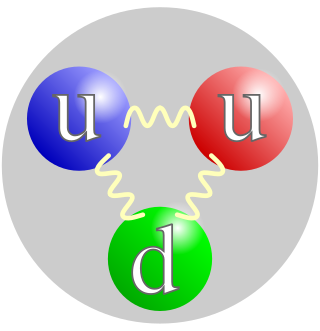
Nuclear fusion is a reaction in which two or more atomic nuclei are combined to form one or more different atomic nuclei and subatomic particles. The difference in mass between the reactants and products is manifested as either the release or the absorption of energy. This difference in mass arises due to the difference in nuclear binding energy between the nuclei before and after the reaction. Nuclear fusion is the process that powers active or main sequence stars and other high-magnitude stars, where large amounts of energy are released.

In chemistry and physics, a nucleon is either a proton or a neutron, considered in its role as a component of an atomic nucleus. The number of nucleons in a nucleus defines the atom's mass number.

A proton is a stable subatomic particle, symbol
p
or
p+
, with a positive electric charge of +1e elementary charge. Its mass is slightly less than that of a neutron and 1836 times the mass of an electron. Protons and neutrons, each with masses of approximately one atomic mass unit, are jointly referred to as "nucleons".

In nuclear physics and particle physics, the strong interaction (strong nuclear force) is one of the four known fundamental interactions, with the others being electromagnetism, the weak interaction (weak nuclear force), and gravitation. At the range of 10−15 m (slightly more than the radius of a nucleon), the strong force is approximately 137 times as strong as electromagnetism, 106 times as strong as the weak interaction, and 1038 times as strong as gravitation. The strong nuclear force confines quarks into hadron particles such as the proton and neutron. In addition, the strong force binds these neutrons and protons to create atomic nuclei, where it is called the nuclear force. Most of the mass of a common proton or neutron is the result of the strong force field energy; the individual quarks provide only about 1% of the mass of a proton.

Gargamelle was a heavy liquid bubble chamber detector in operation at CERN between 1970 and 1979. It was designed to detect neutrinos and antineutrinos, which were produced with a beam from the Proton Synchrotron (PS) between 1970 and 1976, before the detector was moved to the Super Proton Synchrotron (SPS). In 1979 an irreparable crack was discovered in the bubble chamber, and the detector was decommissioned. It is currently part of the "Microcosm" exhibition at CERN, open to the public.
In particle theory, the skyrmion is a topologically stable field configuration of a certain class of non-linear sigma models. It was originally proposed as a model of the nucleon by Tony Skyrme in 1961. As a topological soliton in the pion field, it has the remarkable property of being able to model, with reasonable accuracy, multiple low-energy properties of the nucleon, simply by fixing the nucleon radius. It has since found application in solid-state physics, as well as having ties to certain areas of string theory.
The nuclear magnetic moment is the magnetic moment of an atomic nucleus and arises from the spin of the protons and neutrons. It is mainly a magnetic dipole moment; the quadrupole moment does cause some small shifts in the hyperfine structure as well. All nuclei that have nonzero spin also possess a nonzero magnetic moment and vice versa, although the connection between the two quantities is not straightforward or easy to calculate.

The nuclear force is a force that acts between the protons and neutrons of atoms. Neutrons and protons, both nucleons, are affected by the nuclear force almost identically. Since protons have charge +1 e, they experience an electric force that tends to push them apart, but at short range the attractive nuclear force is strong enough to overcome the electromagnetic force. The nuclear force binds nucleons into atomic nuclei.

Nuclear binding energy in experimental physics is the minimum energy that is required to disassemble the nucleus of an atom into its constituent protons and neutrons, known collectively as nucleons. The binding energy for stable nuclei is always a positive number, as the nucleus must gain energy for the nucleons to move apart from each other. Nucleons are attracted to each other by the strong nuclear force. In theoretical nuclear physics, the nuclear binding energy is considered a negative number. In this context it represents the energy of the nucleus relative to the energy of the constituent nucleons when they are infinitely far apart. Both the experimental and theoretical views are equivalent, with slightly different emphasis on what the binding energy means.
Asım Orhan Barut was a Turkish-American theoretical physicist.
The Delta baryons are a family of subatomic particle made of three up or down quarks.

The Mainz Microtron, abbreviated MAMI, is a microtron which provides a continuous wave, high intensity, polarized electron beam with an energy up to 1.6 GeV. MAMI is the core of an experimental facility for particle, nuclear and X-ray radiation physics at the Johannes Gutenberg University in Mainz (Germany). It is one of the largest campus-based accelerator facilities for basic research in Europe. The experiments at MAMI are performed by about 200 physicists of many countries organized in international collaborations.
In elementary particle physics and mathematical physics, in particular in effective field theory, a form factor is a function that encapsulates the properties of a certain particle interaction without including all of the underlying physics, but instead, providing the momentum dependence of suitable matrix elements. It is further measured experimentally in confirmation or specification of a theory—see experimental particle physics.
The neutron magnetic moment is the intrinsic magnetic dipole moment of the neutron, symbol μn. Protons and neutrons, both nucleons, comprise the nucleus of atoms, and both nucleons behave as small magnets whose strengths are measured by their magnetic moments. The neutron interacts with normal matter through either the nuclear force or its magnetic moment. The neutron's magnetic moment is exploited to probe the atomic structure of materials using scattering methods and to manipulate the properties of neutron beams in particle accelerators. The neutron was determined to have a magnetic moment by indirect methods in the mid 1930s. Luis Alvarez and Felix Bloch made the first accurate, direct measurement of the neutron's magnetic moment in 1940. The existence of the neutron's magnetic moment indicates the neutron is not an elementary particle, because for an elementary particle to have an intrinsic magnetic moment, it must have both spin and electric charge. The neutron has spin 1/2 ħ, but no net charge. The existence of the neutron's magnetic moment was puzzling and defied a correct explanation until the quark model for particles was developed in the 1960s. The neutron is composed of three quarks, and the magnetic moments of these elementary particles combine to give the neutron its magnetic moment.

The Solar Anomalous and Magnetospheric Particle Explorer was a NASA solar and magnetospheric observatory, and was the first spacecraft in the Small Explorer program. It was launched into low Earth orbit on 3 July 1992, from Vandenberg Air Force Base aboard a Scout G-1 launch vehicle. SAMPEX was an international collaboration between NASA and the Max Planck Institute for Extraterrestrial Physics of Germany. The Solar Anomalous and Magnetospheric Particle Explorer (SAMPEX) is the first of a series of spacecraft that was launched under the Small Explorer (SMEX) mission of program for low cost spacecraft.

The atomic nucleus is the small, dense region consisting of protons and neutrons at the center of an atom, discovered in 1911 by Ernest Rutherford based on the 1909 Geiger–Marsden gold foil experiment. After the discovery of the neutron in 1932, models for a nucleus composed of protons and neutrons were quickly developed by Dmitri Ivanenko and Werner Heisenberg. An atom is composed of a positively charged nucleus, with a cloud of negatively charged electrons surrounding it, bound together by electrostatic force. Almost all of the mass of an atom is located in the nucleus, with a very small contribution from the electron cloud. Protons and neutrons are bound together to form a nucleus by the nuclear force.
The structure function, like the fragmentation function, is a probability density function in physics. It is somewhat analogous to the structure factor in solid-state physics, and the form factor.

AMPTE-Charge Composition Explorer, also called as AMPTE-CCE or Explorer 65, was a NASA satellite designed and tasked to study the magnetosphere of Earth, being launched as part of the Explorer program. The AMPTE mission was designed to study the access of solar wind ions to the magnetosphere, the convective-diffusive transport and energization of magnetospheric particles, and the interactions of plasmas in space.

Jonas Alster is an Israeli nuclear physicist.









